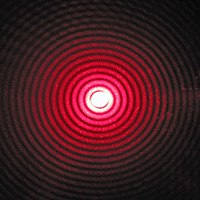
Photo from wikipedia
Integrating geometric and diffractive optics functions is urgently needed to develop compact equipment for integrating diffraction manipulation and arrayed outputs. In this Letter, a superimposed three-level-grooved surface is proposed to… Click to show full abstract
Integrating geometric and diffractive optics functions is urgently needed to develop compact equipment for integrating diffraction manipulation and arrayed outputs. In this Letter, a superimposed three-level-grooved surface is proposed to manipulate the diffraction of visible light and provide an array output. Structure design, vibration-assisted fly-cutting, finite-difference time-domain calculations, and diffraction tests are conducted to fabricate the three-level grooves and explore the diffraction mechanism. Nanogrooves with a period close to the middle wavelength of the spectrum primarily enhances the diffraction at low diffraction orders and angles because of resonance. Optical tests prove that these superimposed three-level nanogrooves have a large bandwidth when providing the array output and serving to control and transmit diffracted light. They also show stronger performance for manipulating low diffraction orders.
Journal Title: Optics letters
Year Published: 2022
Link to full text (if available)
Share on Social Media: Sign Up to like & get
recommendations!